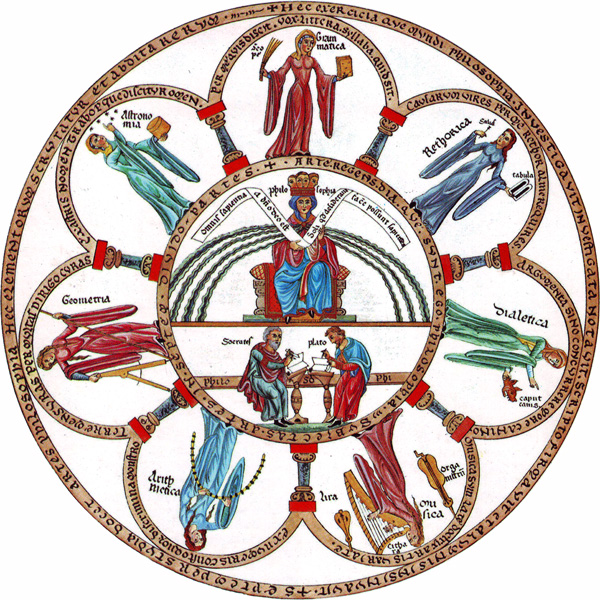Herrad of Landsberg was an amazing woman from the 12th century. She was a very well-educated abbess, and her community resided at the Hohenburg Abbey in Eastern France. She’s allegedly the first woman to write an encyclopedia. Herrad was born about 30 years after Hildegard of Bingen, another woman who is on this list. Not saying where she’ll turn up though!
Wanting to pass on her knowledge to her fellow nuns, she spent over two decades writing the illuminated encyclopedia Hortus deliciarum, which is Latin for Garden of Delights. The manuscript contained a diverse set of material, including:
- A summary of 12th century knowledge
- Poems
- Songs
- Illustrations
- Mandalas (of course!)
The mandala above actually comes from the encyclopedia, and is called: Philosophy and the Seven Liberal Arts. This work of art gives us insights into 12th century education at the abbey.
A woman sits at the upper center off the mandala, making her the central focus for this piece. The woman calls to mind Lady Wisdom, who is the personification of wisdom in Proverbs 8. Divided between both sides of her head is the word Philosophy. There are four streams of water coming from Lady Wisdom’s right (our left), and three coming from the other side. These streams serve to embody wisdom’s influence in each of the seven liberal arts.
Wisdom is also holding a banner which states: “All wisdom comes from God; only the wise can achieve what they desire.” This again brings us back to Proverbs, specifically Proverbs 2:6:
“For the Lord gives wisdom; from his mouth come knowledge and understanding.” (NIV)
Finally, below Lady Wisdom are Socrates and Plato. Contrary to Vizzini’s opinion, they’re not morons.
Around the edges of the mandala are seven semi-circles, which expand upon the seven liberal arts of the 12th century. Within each semi-circle is a woman (possibly Lady Wisdom?) holding an object or objects to symbolize a particular liberal art. Each “rim” of the semi-circle has Latin text embedded within, accompanying the image. We’ll briefly go over these semi-circles below:
12 o’clock: Grammar. The woman is holding a book, and an object that looks like a small broom. The Latin text reads: “Through me, all can learn what are the words, the syllables, and the letters.”
2 o’clock: Rhetoric. On her left hand, the woman is holding a tablet resembling the 10 commandments. However, she’s looking at the writing instrument in her other hand. The text reads: “Thanks to me, proud speaker, your speeches will gain strength.”
4 o’clock: Dialectic. The woman is looking down, pointing at the Latin text with her right hand, while holding a small dog in her left. The Latin text here is: “My arguments are followed quickly, just like the dog’s barking.”
5 o’clock: Music. Here the woman is playing a harp, and the two instruments beside her are a lira (also spelled lyra) and an organistrum. The organistrum looks like the mediaeval version of a hurdy-gurdy (a stringed instrument with a crank connected to its base). The text here is: “I teach my art using a variety of instruments.”
7 o’clock: Arithmetic. The women is holding a 12th century, European abacus (tool used for counting) made up of beads and wire. The Latin text reads: “I base myself on the numbers and show the proportions between them.”
9 o’clock: Geometry. This time, the woman is holding a staff and compass, and the text reads: “It is with exactness that I survey the ground.”
11 o’clock: Astronomy. The last liberal art in the list. Here, the woman points towards the heavens, and holds a cylindrical object in her left hand. I’m not totally sure what the cylindrical object is. My best guess is that it’s a case holding a primitive apparatus, and the apparatus displays the motion of celestial bodies. The Latin text here is: “I hold the names of the celestial bodies and know their future course.”

